| Listing 1 - 10 of 10 |
Sort by
|

ISBN: 0691081123 1400881706 Year: 1972 Publisher: Princeton (N.J.) : Princeton university press,
Abstract | Keywords | Export | Availability | Bookmark
 Loading...
Loading...Choose an application
- Reference Manager
- EndNote
- RefWorks (Direct export to RefWorks)
An especially timely work, the book is an introduction to the theory of p-adic L-functions originated by Kubota and Leopoldt in 1964 as p-adic analogues of the classical L-functions of Dirichlet.Professor Iwasawa reviews the classical results on Dirichlet's L-functions and sketches a proof for some of them. Next he defines generalized Bernoulli numbers and discusses some of their fundamental properties. Continuing, he defines p-adic L-functions, proves their existence and uniqueness, and treats p-adic logarithms and p-adic regulators. He proves a formula of Leopoldt for the values of p-adic L-functions at s=1. The formula was announced in 1964, but a proof has never before been published. Finally, he discusses some applications, especially the strong relationship with cyclotomic fields.
Number theory --- 511.6 --- Algebraic number theory --- L-functions --- Functions, L --- -Number theory --- Algebraic number fields --- Algebraic number theory. --- L-functions. --- 511.6 Algebraic number fields --- -511.6 Algebraic number fields --- Abelian extension. --- Absolute value. --- Algebraic closure. --- Algebraic number field. --- Algebraic number. --- Algebraically closed field. --- Arithmetic function. --- Class field theory. --- Complex number. --- Conjecture. --- Cyclotomic field. --- Dirichlet character. --- Existential quantification. --- Finite group. --- Integer. --- L-function. --- Mellin transform. --- Meromorphic function. --- Multiplicative group. --- P-adic L-function. --- P-adic number. --- Power series. --- Prime number. --- Quadratic field. --- Rational number. --- Real number. --- Root of unity. --- Scientific notation. --- Series (mathematics). --- Special case. --- Subgroup. --- Theorem. --- Topology. --- Nombres, Théorie des
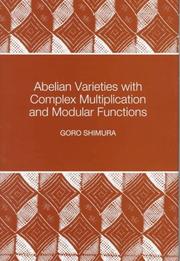
ISBN: 0691016569 1400883946 9780691016566 Year: 1998 Volume: 46 Publisher: Princeton (N.J.): Princeton university press,
Abstract | Keywords | Export | Availability | Bookmark
 Loading...
Loading...Choose an application
- Reference Manager
- EndNote
- RefWorks (Direct export to RefWorks)
Reciprocity laws of various kinds play a central role in number theory. In the easiest case, one obtains a transparent formulation by means of roots of unity, which are special values of exponential functions. A similar theory can be developed for special values of elliptic or elliptic modular functions, and is called complex multiplication of such functions. In 1900 Hilbert proposed the generalization of these as the twelfth of his famous problems. In this book, Goro Shimura provides the most comprehensive generalizations of this type by stating several reciprocity laws in terms of abelian varieties, theta functions, and modular functions of several variables, including Siegel modular functions. This subject is closely connected with the zeta function of an abelian variety, which is also covered as a main theme in the book. The third topic explored by Shimura is the various algebraic relations among the periods of abelian integrals. The investigation of such algebraicity is relatively new, but has attracted the interest of increasingly many researchers. Many of the topics discussed in this book have not been covered before. In particular, this is the first book in which the topics of various algebraic relations among the periods of abelian integrals, as well as the special values of theta and Siegel modular functions, are treated extensively.
Ordered algebraic structures --- 512.74 --- Abelian varieties --- Modular functions --- Functions, Modular --- Elliptic functions --- Group theory --- Number theory --- Varieties, Abelian --- Geometry, Algebraic --- Algebraic groups. Abelian varieties --- 512.74 Algebraic groups. Abelian varieties --- Abelian varieties. --- Modular functions. --- Abelian extension. --- Abelian group. --- Abelian variety. --- Absolute value. --- Adele ring. --- Affine space. --- Affine variety. --- Algebraic closure. --- Algebraic equation. --- Algebraic extension. --- Algebraic number field. --- Algebraic structure. --- Algebraic variety. --- Analytic manifold. --- Automorphic function. --- Automorphism. --- Big O notation. --- CM-field. --- Characteristic polynomial. --- Class field theory. --- Coefficient. --- Complete variety. --- Complex conjugate. --- Complex multiplication. --- Complex number. --- Complex torus. --- Corollary. --- Degenerate bilinear form. --- Differential form. --- Direct product. --- Direct proof. --- Discrete valuation ring. --- Divisor. --- Eigenvalues and eigenvectors. --- Embedding. --- Endomorphism. --- Existential quantification. --- Field of fractions. --- Finite field. --- Fractional ideal. --- Function (mathematics). --- Fundamental theorem. --- Galois extension. --- Galois group. --- Galois theory. --- Generic point. --- Ground field. --- Group theory. --- Groupoid. --- Hecke character. --- Homology (mathematics). --- Homomorphism. --- Identity element. --- Integer. --- Irreducibility (mathematics). --- Irreducible representation. --- Lie group. --- Linear combination. --- Linear subspace. --- Local ring. --- Modular form. --- Natural number. --- Number theory. --- Polynomial. --- Prime factor. --- Prime ideal. --- Projective space. --- Projective variety. --- Rational function. --- Rational mapping. --- Rational number. --- Real number. --- Residue field. --- Riemann hypothesis. --- Root of unity. --- Scientific notation. --- Semisimple algebra. --- Simple algebra. --- Singular value. --- Special case. --- Subgroup. --- Subring. --- Subset. --- Summation. --- Theorem. --- Vector space. --- Zero element.
Book
ISBN: 0691036810 0691036756 1400882540 9780691036755 9780691036816 Year: 1994 Volume: 133 Publisher: Princeton (N.J.): Princeton university press,
Abstract | Keywords | Export | Availability | Bookmark
 Loading...
Loading...Choose an application
- Reference Manager
- EndNote
- RefWorks (Direct export to RefWorks)
Written for advanced undergraduate and first-year graduate students, this book aims to introduce students to a serious level of p-adic analysis with important implications for number theory. The main object is the study of G-series, that is, power series y=aij=0 Ajxj with coefficients in an algebraic number field K. These series satisfy a linear differential equation Ly=0 with LIK(x) [d/dx] and have non-zero radii of convergence for each imbedding of K into the complex numbers. They have the further property that the common denominators of the first s coefficients go to infinity geometrically with the index s. After presenting a review of valuation theory and elementary p-adic analysis together with an application to the congruence zeta function, this book offers a detailed study of the p-adic properties of formal power series solutions of linear differential equations. In particular, the p-adic radii of convergence and the p-adic growth of coefficients are studied. Recent work of Christol, Bombieri, André, and Dwork is treated and augmented. The book concludes with Chudnovsky's theorem: the analytic continuation of a G -series is again a G -series. This book will be indispensable for those wishing to study the work of Bombieri and André on global relations and for the study of the arithmetic properties of solutions of ordinary differential equations.
Analyse p-adique --- H-fonction --- H-functie --- H-function --- p-adic analyse --- p-adic analysis --- H-functions --- H-functions. --- p-adic analysis. --- Analysis, p-adic --- Algebra --- Calculus --- Geometry, Algebraic --- Fox's H-function --- G-functions, Generalized --- Generalized G-functions --- Generalized Mellin-Barnes functions --- Mellin-Barnes functions, Generalized --- Hypergeometric functions --- Adjoint. --- Algebraic Method. --- Algebraic closure. --- Algebraic number field. --- Algebraic number theory. --- Algebraic variety. --- Algebraically closed field. --- Analytic continuation. --- Analytic function. --- Argument principle. --- Arithmetic. --- Automorphism. --- Bearing (navigation). --- Binomial series. --- Calculation. --- Cardinality. --- Cartesian coordinate system. --- Cauchy sequence. --- Cauchy's theorem (geometry). --- Coefficient. --- Cohomology. --- Commutative ring. --- Complete intersection. --- Complex analysis. --- Conjecture. --- Density theorem. --- Differential equation. --- Dimension (vector space). --- Direct sum. --- Discrete valuation. --- Eigenvalues and eigenvectors. --- Elliptic curve. --- Equation. --- Equivalence class. --- Estimation. --- Existential quantification. --- Exponential function. --- Exterior algebra. --- Field of fractions. --- Finite field. --- Formal power series. --- Fuchs' theorem. --- G-module. --- Galois extension. --- Galois group. --- General linear group. --- Generic point. --- Geometry. --- Hypergeometric function. --- Identity matrix. --- Inequality (mathematics). --- Intercept method. --- Irreducible element. --- Irreducible polynomial. --- Laurent series. --- Limit of a sequence. --- Linear differential equation. --- Lowest common denominator. --- Mathematical induction. --- Meromorphic function. --- Modular arithmetic. --- Module (mathematics). --- Monodromy. --- Monotonic function. --- Multiplicative group. --- Natural number. --- Newton polygon. --- Number theory. --- P-adic number. --- Parameter. --- Permutation. --- Polygon. --- Polynomial. --- Projective line. --- Q.E.D. --- Quadratic residue. --- Radius of convergence. --- Rational function. --- Rational number. --- Residue field. --- Riemann hypothesis. --- Ring of integers. --- Root of unity. --- Separable polynomial. --- Sequence. --- Siegel's lemma. --- Special case. --- Square root. --- Subring. --- Subset. --- Summation. --- Theorem. --- Topology of uniform convergence. --- Transpose. --- Triangle inequality. --- Unipotent. --- Valuation ring. --- Weil conjecture. --- Wronskian. --- Y-intercept.
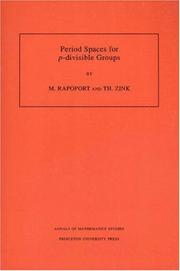
ISBN: 0691027811 1400882605 9780691027814 Year: 1996 Volume: 141 Publisher: Princeton (N.J.): Princeton university press,
Abstract | Keywords | Export | Availability | Bookmark
 Loading...
Loading...Choose an application
- Reference Manager
- EndNote
- RefWorks (Direct export to RefWorks)
In this monograph p-adic period domains are associated to arbitrary reductive groups. Using the concept of rigid-analytic period maps the relation of p-adic period domains to moduli space of p-divisible groups is investigated. In addition, non-archimedean uniformization theorems for general Shimura varieties are established. The exposition includes background material on Grothendieck's "mysterious functor" (Fontaine theory), on moduli problems of p-divisible groups, on rigid analytic spaces, and on the theory of Shimura varieties, as well as an exposition of some aspects of Drinfelds' original construction. In addition, the material is illustrated throughout the book with numerous examples.
p-adic groups --- p-divisible groups --- Moduli theory --- 512.7 --- Theory of moduli --- Analytic spaces --- Functions of several complex variables --- Geometry, Algebraic --- Groups, p-divisible --- Group schemes (Mathematics) --- Groups, p-adic --- Group theory --- Algebraic geometry. Commutative rings and algebras --- 512.7 Algebraic geometry. Commutative rings and algebras --- p-divisible groups. --- Moduli theory. --- p-adic groups. --- Abelian variety. --- Addition. --- Alexander Grothendieck. --- Algebraic closure. --- Algebraic number field. --- Algebraic space. --- Algebraically closed field. --- Artinian ring. --- Automorphism. --- Base change. --- Basis (linear algebra). --- Big O notation. --- Bilinear form. --- Canonical map. --- Cohomology. --- Cokernel. --- Commutative algebra. --- Commutative ring. --- Complex multiplication. --- Conjecture. --- Covering space. --- Degenerate bilinear form. --- Diagram (category theory). --- Dimension (vector space). --- Dimension. --- Duality (mathematics). --- Elementary function. --- Epimorphism. --- Equation. --- Existential quantification. --- Fiber bundle. --- Field of fractions. --- Finite field. --- Formal scheme. --- Functor. --- Galois group. --- General linear group. --- Geometric invariant theory. --- Hensel's lemma. --- Homomorphism. --- Initial and terminal objects. --- Inner automorphism. --- Integral domain. --- Irreducible component. --- Isogeny. --- Isomorphism class. --- Linear algebra. --- Linear algebraic group. --- Local ring. --- Local system. --- Mathematical induction. --- Maximal ideal. --- Maximal torus. --- Module (mathematics). --- Moduli space. --- Monomorphism. --- Morita equivalence. --- Morphism. --- Multiplicative group. --- Noetherian ring. --- Open set. --- Orthogonal basis. --- Orthogonal complement. --- Orthonormal basis. --- P-adic number. --- Parity (mathematics). --- Period mapping. --- Prime element. --- Prime number. --- Projective line. --- Projective space. --- Quaternion algebra. --- Reductive group. --- Residue field. --- Rigid analytic space. --- Semisimple algebra. --- Sheaf (mathematics). --- Shimura variety. --- Special case. --- Subalgebra. --- Subgroup. --- Subset. --- Summation. --- Supersingular elliptic curve. --- Support (mathematics). --- Surjective function. --- Symmetric bilinear form. --- Symmetric space. --- Tate module. --- Tensor algebra. --- Tensor product. --- Theorem. --- Topological ring. --- Topology. --- Torsor (algebraic geometry). --- Uniformization theorem. --- Uniformization. --- Unitary group. --- Weil group. --- Zariski topology.
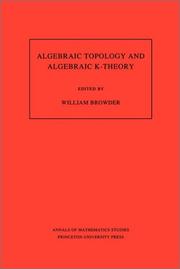
ISBN: 0691084157 0691084262 1400882117 Year: 1987 Publisher: Princeton : Princeton University Press,
Abstract | Keywords | Export | Availability | Bookmark
 Loading...
Loading...Choose an application
- Reference Manager
- EndNote
- RefWorks (Direct export to RefWorks)
This book contains accounts of talks held at a symposium in honorof John C. Moore in October 1983 at Princeton University, The workincludes papers in classical homotopy theory, homological algebra,rational homotopy theory, algebraic K-theory of spaces, and othersubjects.
Algebraic topology --- K-theory --- 512.73 --- 515.14 --- 512.73 Cohomology theory of algebraic varieties and schemes --- Cohomology theory of algebraic varieties and schemes --- 515.14 Algebraic topology --- Moore, John C. --- Abelian group. --- Adams spectral sequence. --- Adjoint functors. --- Adjunction (field theory). --- Algebraic K-theory. --- Algebraic closure. --- Algebraic geometry. --- Algebraic group. --- Algebraic number field. --- Algebraic space. --- Algebraic topology. --- Algebraically closed field. --- Associative algebra. --- Boundary (topology). --- CW complex. --- Classification theorem. --- Closure (mathematics). --- Coalgebra. --- Cofibration. --- Cohomology. --- Commutative diagram. --- Commutative property. --- Coproduct. --- Deformation theory. --- Degenerate bilinear form. --- Diagram (category theory). --- Differentiable manifold. --- Dimension (vector space). --- Division algebra. --- Eilenberg–Moore spectral sequence. --- Epimorphism. --- Exterior (topology). --- Formal power series. --- Free Lie algebra. --- Free algebra. --- Freudenthal suspension theorem. --- Function (mathematics). --- Function space. --- Functor. --- G-module. --- Galois extension. --- Global dimension. --- Group cohomology. --- Group homomorphism. --- H-space. --- Hilbert's Theorem 90. --- Homology (mathematics). --- Homomorphism. --- Homotopy category. --- Homotopy group. --- Homotopy. --- Hopf algebra. --- Hopf invariant. --- Hurewicz theorem. --- Inclusion map. --- Inequality (mathematics). --- Integral domain. --- Isometry. --- Isomorphism class. --- K-theory. --- Lie algebra. --- Lie group. --- Limit (category theory). --- Loop space. --- Mathematician. --- Mathematics. --- Noetherian ring. --- Order topology. --- P-adic number. --- Polynomial ring. --- Polynomial. --- Prime number. --- Principal bundle. --- Principal ideal domain. --- Projective module. --- Projective plane. --- Pullback (category theory). --- Pushout (category theory). --- Ring of integers. --- Series (mathematics). --- Sheaf (mathematics). --- Simplicial category. --- Simplicial complex. --- Simplicial set. --- Special case. --- Spectral sequence. --- Square (algebra). --- Stable homotopy theory. --- Steenrod algebra. --- Superalgebra. --- Theorem. --- Topological K-theory. --- Topological space. --- Topology. --- Triviality (mathematics). --- Uniqueness theorem. --- Universal enveloping algebra. --- Vector bundle. --- Weak equivalence (homotopy theory). --- William Browder (mathematician). --- Géométrie algébrique --- K-théorie
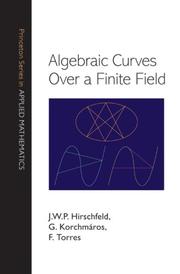
ISBN: 1400847419 9781400847419 1306988608 9781306988605 9781400847426 1400847427 0691096791 9780691096797 9780691096797 Year: 2008 Publisher: Princeton, New Jersey
Abstract | Keywords | Export | Availability | Bookmark
 Loading...
Loading...Choose an application
- Reference Manager
- EndNote
- RefWorks (Direct export to RefWorks)
This book provides an accessible and self-contained introduction to the theory of algebraic curves over a finite field, a subject that has been of fundamental importance to mathematics for many years and that has essential applications in areas such as finite geometry, number theory, error-correcting codes, and cryptology. Unlike other books, this one emphasizes the algebraic geometry rather than the function field approach to algebraic curves. The authors begin by developing the general theory of curves over any field, highlighting peculiarities occurring for positive characteristic and requiring of the reader only basic knowledge of algebra and geometry. The special properties that a curve over a finite field can have are then discussed. The geometrical theory of linear series is used to find estimates for the number of rational points on a curve, following the theory of Stöhr and Voloch. The approach of Hasse and Weil via zeta functions is explained, and then attention turns to more advanced results: a state-of-the-art introduction to maximal curves over finite fields is provided; a comprehensive account is given of the automorphism group of a curve; and some applications to coding theory and finite geometry are described. The book includes many examples and exercises. It is an indispensable resource for researchers and the ideal textbook for graduate students.
Curves, Algebraic. --- Finite fields (Algebra) --- Modular fields (Algebra) --- Algebra, Abstract --- Algebraic fields --- Galois theory --- Modules (Algebra) --- Algebraic curves --- Algebraic varieties --- Abelian group. --- Abelian variety. --- Affine plane. --- Affine space. --- Affine variety. --- Algebraic closure. --- Algebraic curve. --- Algebraic equation. --- Algebraic extension. --- Algebraic function. --- Algebraic geometry. --- Algebraic integer. --- Algebraic number field. --- Algebraic number theory. --- Algebraic number. --- Algebraic variety. --- Algebraically closed field. --- Applied mathematics. --- Automorphism. --- Birational invariant. --- Characteristic exponent. --- Classification theorem. --- Clifford's theorem. --- Combinatorics. --- Complex number. --- Computation. --- Cyclic group. --- Cyclotomic polynomial. --- Degeneracy (mathematics). --- Degenerate conic. --- Divisor (algebraic geometry). --- Divisor. --- Dual curve. --- Dual space. --- Elliptic curve. --- Equation. --- Fermat curve. --- Finite field. --- Finite geometry. --- Finite group. --- Formal power series. --- Function (mathematics). --- Function field. --- Fundamental theorem. --- Galois extension. --- Galois theory. --- Gauss map. --- General position. --- Generic point. --- Geometry. --- Homogeneous polynomial. --- Hurwitz's theorem. --- Hyperelliptic curve. --- Hyperplane. --- Identity matrix. --- Inequality (mathematics). --- Intersection number (graph theory). --- Intersection number. --- J-invariant. --- Line at infinity. --- Linear algebra. --- Linear map. --- Mathematical induction. --- Mathematics. --- Menelaus' theorem. --- Modular curve. --- Natural number. --- Number theory. --- Parity (mathematics). --- Permutation group. --- Plane curve. --- Point at infinity. --- Polar curve. --- Polygon. --- Polynomial. --- Power series. --- Prime number. --- Projective plane. --- Projective space. --- Quadratic transformation. --- Quadric. --- Resolution of singularities. --- Riemann hypothesis. --- Scalar multiplication. --- Scientific notation. --- Separable extension. --- Separable polynomial. --- Sign (mathematics). --- Singular point of a curve. --- Special case. --- Subgroup. --- Sylow theorems. --- System of linear equations. --- Tangent. --- Theorem. --- Transcendence degree. --- Upper and lower bounds. --- Valuation ring. --- Variable (mathematics). --- Vector space.
Book
ISBN: 0691618127 0691645167 1400871336 9781400871339 0691081654 9780691081656 Year: 2015 Volume: 15 Publisher: Princeton Princeton University Press
Abstract | Keywords | Export | Availability | Bookmark
 Loading...
Loading...Choose an application
- Reference Manager
- EndNote
- RefWorks (Direct export to RefWorks)
This book presents a development of the basic facts about harmonic analysis on local fields and the n-dimensional vector spaces over these fields. It focuses almost exclusively on the analogy between the local field and Euclidean cases, with respect to the form of statements, the manner of proof, and the variety of applications.The force of the analogy between the local field and Euclidean cases rests in the relationship of the field structures that underlie the respective cases. A complete classification of locally compact, non-discrete fields gives us two examples of connected fields (real and complex numbers); the rest are local fields (p-adic numbers, p-series fields, and their algebraic extensions). The local fields are studied in an effort to extend knowledge of the reals and complexes as locally compact fields.The author's central aim has been to present the basic facts of Fourier analysis on local fields in an accessible form and in the same spirit as in Zygmund's Trigonometric Series (Cambridge, 1968) and in Introduction to Fourier Analysis on Euclidean Spaces by Stein and Weiss (1971).Originally published in 1975.The Princeton Legacy Library uses the latest print-on-demand technology to again make available previously out-of-print books from the distinguished backlist of Princeton University Press. These editions preserve the original texts of these important books while presenting them in durable paperback and hardcover editions. The goal of the Princeton Legacy Library is to vastly increase access to the rich scholarly heritage found in the thousands of books published by Princeton University Press since its founding in 1905.
Fourier analysis. --- Local fields (Algebra) --- Fields, Local (Algebra) --- Algebraic fields --- Analysis, Fourier --- Mathematical analysis --- Corps algébriques --- Fourier analysis --- 511 --- 511 Number theory --- Number theory --- Local fields (Algebra). --- Harmonic analysis. Fourier analysis --- Fourier Analysis --- Abelian group. --- Absolute continuity. --- Absolute value. --- Addition. --- Additive group. --- Algebraic extension. --- Algebraic number field. --- Bessel function. --- Beta function. --- Borel measure. --- Bounded function. --- Bounded variation. --- Boundedness. --- Calculation. --- Cauchy–Riemann equations. --- Characteristic function (probability theory). --- Complex analysis. --- Conformal map. --- Continuous function. --- Convolution. --- Coprime integers. --- Corollary. --- Coset. --- Determinant. --- Dimension (vector space). --- Dimension. --- Dirichlet kernel. --- Discrete space. --- Distribution (mathematics). --- Endomorphism. --- Field of fractions. --- Finite field. --- Formal power series. --- Fourier series. --- Fourier transform. --- Gamma function. --- Gelfand. --- Haar measure. --- Haar wavelet. --- Half-space (geometry). --- Hankel transform. --- Hardy's inequality. --- Harmonic analysis. --- Harmonic function. --- Homogeneous distribution. --- Integer. --- Lebesgue integration. --- Linear combination. --- Linear difference equation. --- Linear map. --- Linear space (geometry). --- Local field. --- Lp space. --- Maximal ideal. --- Measurable function. --- Measure (mathematics). --- Mellin transform. --- Metric space. --- Modular form. --- Multiplicative group. --- Norbert Wiener. --- P-adic number. --- Poisson kernel. --- Power series. --- Prime ideal. --- Probability. --- Product metric. --- Rational number. --- Regularization (mathematics). --- Requirement. --- Ring (mathematics). --- Ring of integers. --- Scalar multiplication. --- Scientific notation. --- Sign (mathematics). --- Smoothness. --- Special case. --- Special functions. --- Subgroup. --- Subring. --- Support (mathematics). --- Theorem. --- Topological space. --- Unitary operator. --- Vector space. --- Analyse harmonique (mathématiques) --- Analyse harmonique (mathématiques) --- Corps algébriques
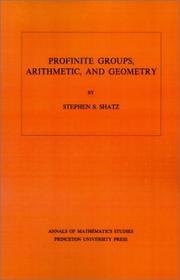
ISBN: 0691080178 1400881854 9780691080178 Year: 1972 Volume: 67 Publisher: Princeton (N.J.): Princeton university press,
Abstract | Keywords | Export | Availability | Bookmark
 Loading...
Loading...Choose an application
- Reference Manager
- EndNote
- RefWorks (Direct export to RefWorks)
In this volume, the author covers profinite groups and their cohomology, Galois cohomology, and local class field theory, and concludes with a treatment of duality. His objective is to present effectively that body of material upon which all modern research in Diophantine geometry and higher arithmetic is based, and to do so in a manner that emphasizes the many interesting lines of inquiry leading from these foundations.
Group theory --- Finite groups --- Algebraic number theory --- 512.73 --- 512.66 --- Homology theory --- Number theory --- Cohomology theory --- Contrahomology theory --- Algebraic topology --- Groups, Finite --- Modules (Algebra) --- Cohomology theory of algebraic varieties and schemes --- Homological algebra --- 512.66 Homological algebra --- 512.73 Cohomology theory of algebraic varieties and schemes --- Groupes, Théorie des. --- Group theory. --- Homology theory. --- Finite groups. --- Algebraic number theory. --- Abelian group. --- Alexander Grothendieck. --- Algebraic closure. --- Algebraic extension. --- Algebraic geometry. --- Algebraic number field. --- Brauer group. --- Category of abelian groups. --- Category of sets. --- Characterization (mathematics). --- Class field theory. --- Cohomological dimension. --- Cohomology. --- Cokernel. --- Commutative diagram. --- Composition series. --- Computation. --- Connected component (graph theory). --- Coset. --- Cup product. --- Dedekind domain. --- Degeneracy (mathematics). --- Diagram (category theory). --- Dimension (vector space). --- Diophantine geometry. --- Discrete group. --- Equivalence of categories. --- Exact sequence. --- Existential quantification. --- Explicit formula. --- Exponential function. --- Family of sets. --- Field extension. --- Finite group. --- Fundamental class. --- G-module. --- Galois cohomology. --- Galois extension. --- Galois group. --- Galois module. --- Galois theory. --- General topology. --- Geometry. --- Grothendieck topology. --- Group cohomology. --- Group extension. --- Group scheme. --- Hilbert symbol. --- Hopf algebra. --- Ideal (ring theory). --- Inequality (mathematics). --- Injective sheaf. --- Inner automorphism. --- Inverse limit. --- Kummer theory. --- Lie algebra. --- Linear independence. --- Local field. --- Mathematical induction. --- Mathematician. --- Mathematics. --- Module (mathematics). --- Morphism. --- Natural topology. --- Neighbourhood (mathematics). --- Normal extension. --- Normal subgroup. --- Number theory. --- P-adic number. --- P-group. --- Polynomial. --- Pontryagin duality. --- Power series. --- Prime number. --- Principal ideal. --- Profinite group. --- Quadratic reciprocity. --- Quotient group. --- Ring of integers. --- Sheaf (mathematics). --- Special case. --- Subcategory. --- Subgroup. --- Supernatural number. --- Sylow theorems. --- Tangent space. --- Theorem. --- Topological group. --- Topological property. --- Topological ring. --- Topological space. --- Topology. --- Torsion group. --- Torsion subgroup. --- Transcendence degree. --- Triviality (mathematics). --- Unique factorization domain. --- Variable (mathematics). --- Vector space. --- Groupes, Théorie des --- Nombres, Théorie des

ISBN: 0691081565 1400881617 9780691081564 Year: 1975 Volume: 83 Publisher: Princeton: Princeton university press,
Abstract | Keywords | Export | Availability | Bookmark
 Loading...
Loading...Choose an application
- Reference Manager
- EndNote
- RefWorks (Direct export to RefWorks)
This volume investigates the interplay between the classical theory of automorphic forms and the modern theory of representations of adele groups. Interpreting important recent contributions of Jacquet and Langlands, the author presents new and previously inaccessible results, and systematically develops explicit consequences and connections with the classical theory. The underlying theme is the decomposition of the regular representation of the adele group of GL(2). A detailed proof of the celebrated trace formula of Selberg is included, with a discussion of the possible range of applicability of this formula. Throughout the work the author emphasizes new examples and problems that remain open within the general theory.TABLE OF CONTENTS: 1. The Classical Theory 2. Automorphic Forms and the Decomposition of L2(PSL(2,R) 3. Automorphic Forms as Functions on the Adele Group of GL(2) 4. The Representations of GL(2) over Local and Global Fields 5. Cusp Forms and Representations of the Adele Group of GL(2) 6. Hecke Theory for GL(2) 7. The Construction of a Special Class of Automorphic Forms 8. Eisenstein Series and the Continuous Spectrum 9. The Trace Formula for GL(2) 10. Automorphic Forms on a Quaternion Algebr?
Number theory --- Representations of groups --- Linear algebraic groups --- Adeles --- Representations of groups. --- Automorphic forms. --- Linear algebraic groups. --- Adeles. --- Nombres, Théorie des --- Formes automorphes --- Automorphic forms --- Algebraic fields --- Algebraic groups, Linear --- Geometry, Algebraic --- Group theory --- Algebraic varieties --- Automorphic functions --- Forms (Mathematics) --- Group representation (Mathematics) --- Groups, Representation theory of --- Nombres, Théorie des. --- Abelian extension. --- Abelian group. --- Absolute value. --- Addition. --- Additive group. --- Algebraic group. --- Algebraic number field. --- Algebraic number theory. --- Analytic continuation. --- Analytic function. --- Arbitrarily large. --- Automorphic form. --- Cartan subgroup. --- Class field theory. --- Complex space. --- Congruence subgroup. --- Conjugacy class. --- Coprime integers. --- Cusp form. --- Differential equation. --- Dimension (vector space). --- Direct integral. --- Direct sum. --- Division algebra. --- Eigenfunction. --- Eigenvalues and eigenvectors. --- Eisenstein series. --- Euler product. --- Existential quantification. --- Exponential function. --- Factorization. --- Finite field. --- Formal power series. --- Fourier series. --- Fourier transform. --- Fuchsian group. --- Function (mathematics). --- Function space. --- Functional equation. --- Fundamental unit (number theory). --- Galois extension. --- Global field. --- Group algebra. --- Group representation. --- Haar measure. --- Harish-Chandra. --- Hecke L-function. --- Hilbert space. --- Homomorphism. --- Induced representation. --- Infinite product. --- Inner automorphism. --- Integer. --- Invariant measure. --- Invariant subspace. --- Irreducible representation. --- L-function. --- Lie algebra. --- Linear map. --- Matrix coefficient. --- Mellin transform. --- Meromorphic function. --- Modular form. --- P-adic number. --- Poisson summation formula. --- Prime ideal. --- Prime number. --- Principal series representation. --- Projective representation. --- Quadratic field. --- Quadratic form. --- Quaternion algebra. --- Quaternion. --- Real number. --- Regular representation. --- Representation theory. --- Ring (mathematics). --- Ring of integers. --- Scientific notation. --- Selberg trace formula. --- Simple algebra. --- Square-integrable function. --- Sub"ient. --- Subgroup. --- Summation. --- Theorem. --- Theory. --- Theta function. --- Topological group. --- Topology. --- Trace formula. --- Trivial representation. --- Uniqueness theorem. --- Unitary operator. --- Unitary representation. --- Universal enveloping algebra. --- Upper half-plane. --- Variable (mathematics). --- Vector space. --- Weil group. --- Nombres, Théorie des
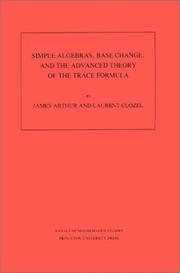
ISBN: 0691085188 069108517X 1400882400 Year: 1989 Volume: vol 120 Publisher: Princeton University Press
Abstract | Keywords | Export | Availability | Bookmark
 Loading...
Loading...Choose an application
- Reference Manager
- EndNote
- RefWorks (Direct export to RefWorks)
A general principle, discovered by Robert Langlands and named by him the "functoriality principle," predicts relations between automorphic forms on arithmetic subgroups of different reductive groups. Langlands functoriality relates the eigenvalues of Hecke operators acting on the automorphic forms on two groups (or the local factors of the "automorphic representations" generated by them). In the few instances where such relations have been probed, they have led to deep arithmetic consequences. This book studies one of the simplest general problems in the theory, that of relating automorphic forms on arithmetic subgroups of GL(n,E) and GL(n,F) when E/F is a cyclic extension of number fields. (This is known as the base change problem for GL(n).) The problem is attacked and solved by means of the trace formula. The book relies on deep and technical results obtained by several authors during the last twenty years. It could not serve as an introduction to them, but, by giving complete references to the published literature, the authors have made the work useful to a reader who does not know all the aspects of the theory of automorphic forms.
511.33 --- Analytical and multiplicative number theory. Asymptotics. Sieves etc. --- 511.33 Analytical and multiplicative number theory. Asymptotics. Sieves etc. --- Automorfe vormen --- Automorphic forms --- Formes automorphes --- Representation des groupes --- Representations of groups --- Trace formulas --- Vertegenwoordiging van groepen --- Formulas, Trace --- Discontinuous groups --- Group representation (Mathematics) --- Groups, Representation theory of --- Group theory --- Automorphic functions --- Forms (Mathematics) --- Analytical and multiplicative number theory. Asymptotics. Sieves etc --- Representations of groups. --- Trace formulas. --- Automorphic forms. --- 0E. --- Addition. --- Admissible representation. --- Algebraic group. --- Algebraic number field. --- Approximation. --- Archimedean property. --- Automorphic form. --- Automorphism. --- Base change. --- Big O notation. --- Binomial coefficient. --- Canonical map. --- Cartan subalgebra. --- Cartan subgroup. --- Central simple algebra. --- Characteristic polynomial. --- Closure (mathematics). --- Combination. --- Computation. --- Conjecture. --- Conjugacy class. --- Connected component (graph theory). --- Continuous function. --- Contradiction. --- Corollary. --- Counting. --- Coxeter element. --- Cusp form. --- Cyclic permutation. --- Dense set. --- Density theorem. --- Determinant. --- Diagram (category theory). --- Discrete series representation. --- Discrete spectrum. --- Division algebra. --- Eigenvalues and eigenvectors. --- Eisenstein series. --- Exact sequence. --- Existential quantification. --- Field extension. --- Finite group. --- Finite set. --- Fourier transform. --- Functor. --- Fundamental lemma (Langlands program). --- Galois extension. --- Galois group. --- Global field. --- Grothendieck group. --- Group representation. --- Haar measure. --- Harmonic analysis. --- Hecke algebra. --- Hilbert's Theorem 90. --- Identity component. --- Induced representation. --- Infinite product. --- Infinitesimal character. --- Invariant measure. --- Irreducibility (mathematics). --- Irreducible representation. --- L-function. --- Langlands classification. --- Laurent series. --- Lie algebra. --- Lie group. --- Linear algebraic group. --- Local field. --- Mathematical induction. --- Maximal compact subgroup. --- Multiplicative group. --- Nilpotent group. --- Orbital integral. --- P-adic number. --- Paley–Wiener theorem. --- Parameter. --- Parametrization. --- Permutation. --- Poisson summation formula. --- Real number. --- Reciprocal lattice. --- Reductive group. --- Root of unity. --- Scientific notation. --- Semidirect product. --- Special case. --- Spherical harmonics. --- Subgroup. --- Subset. --- Summation. --- Support (mathematics). --- Tensor product. --- Theorem. --- Trace formula. --- Unitary representation. --- Weil group. --- Weyl group. --- Zero of a function.
| Listing 1 - 10 of 10 |
Sort by
|

 Search
Search Feedback
Feedback About UniCat
About UniCat  Help
Help News
News